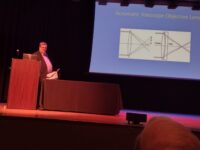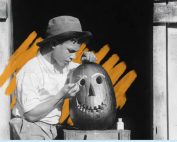SaddleBrooke SkyGazers Get Sirius

SERIOUS REPORTER GLORIA WOLF FOR SBINSIDER| November, 19th, 2023
SaddleBrooke’s own Jay Holberg. PhD., presented the trail of research that led to the discovery of Sirius B at the November 12 meeting of SaddleBrooke Skygazers. Holberg has a PhD from Berkeley and has spent a good part of his career studying the star, Sirius. He also contributed to aspects of the Voyager project at the Jet Propulsion Laboratory and recently retired as a Senior Research Scientist at the Lunar and Planetary Laboratory at the University of Arizona.
Sirius is the brightest star in the night sky and is the eighth nearest star. Big and hot, this star was known in Egypt and Greece, Rome, China, and Polynesia. It is also a favorite among occult secret societies, and some think it is a source of ancient aliens.
Sirius is one point of the winter triangle made up of Sirius, Betelgeuse, and Procyon and part of the Canis Major constellation. Sirius is a binary star with the dominant star being Sirius A accompanied by a white dwarf, Sirius B. The name Sirius is from the Latin word Seirios, translated to ‘glowing’ or ‘scorching.’
The history of the discovery of Sirius B starts in 1844 with W. F. Bessel a German astronomer who noticed the irregular motion of Sirius and Procyon. A lesser-known contributor to the history involves Alvan Clark from Massachusetts who listed himself as a wagon wright, marksman, inventor, engraver, and telescope maker. In 1862 he set up shop by the Charles River and built the world’s largest refracting telescope. While viewing Sirius, Clark’s son noticed that Sirius had a companion.
In February of 1862, George P. Bonds, head of the Harvard observatory confirmed the existence of Sirius B. Later that year Jean Chacornac, a junior observer at the Paris Observatory noticed that when Sirius B gets close to Sirius it gets lost from view due to the brightness of Sirius A.
In Greece the appearance of Sirius marked the onset of summer. If you were susceptible to the emanations from the bright, twinkling star Sirius, you might be considered “star struck.” The remainder of the summer following the star’s appearance was known as the “dog days” of summer, referring to its location in Canis Major.
At the beginning of the presentation to the SaddleBrooke Skygazers, Richard Spitzer provides a look forward to interesting things you might see in the night sky. He also organizes the club star parties which are held weather or viewing permitted. Lockwood Carlson also provides an astronomical appetizer to whet your appetite on a topic of astronomy.
Find out more about SaddleBrooke SkyGazers at the following link:








